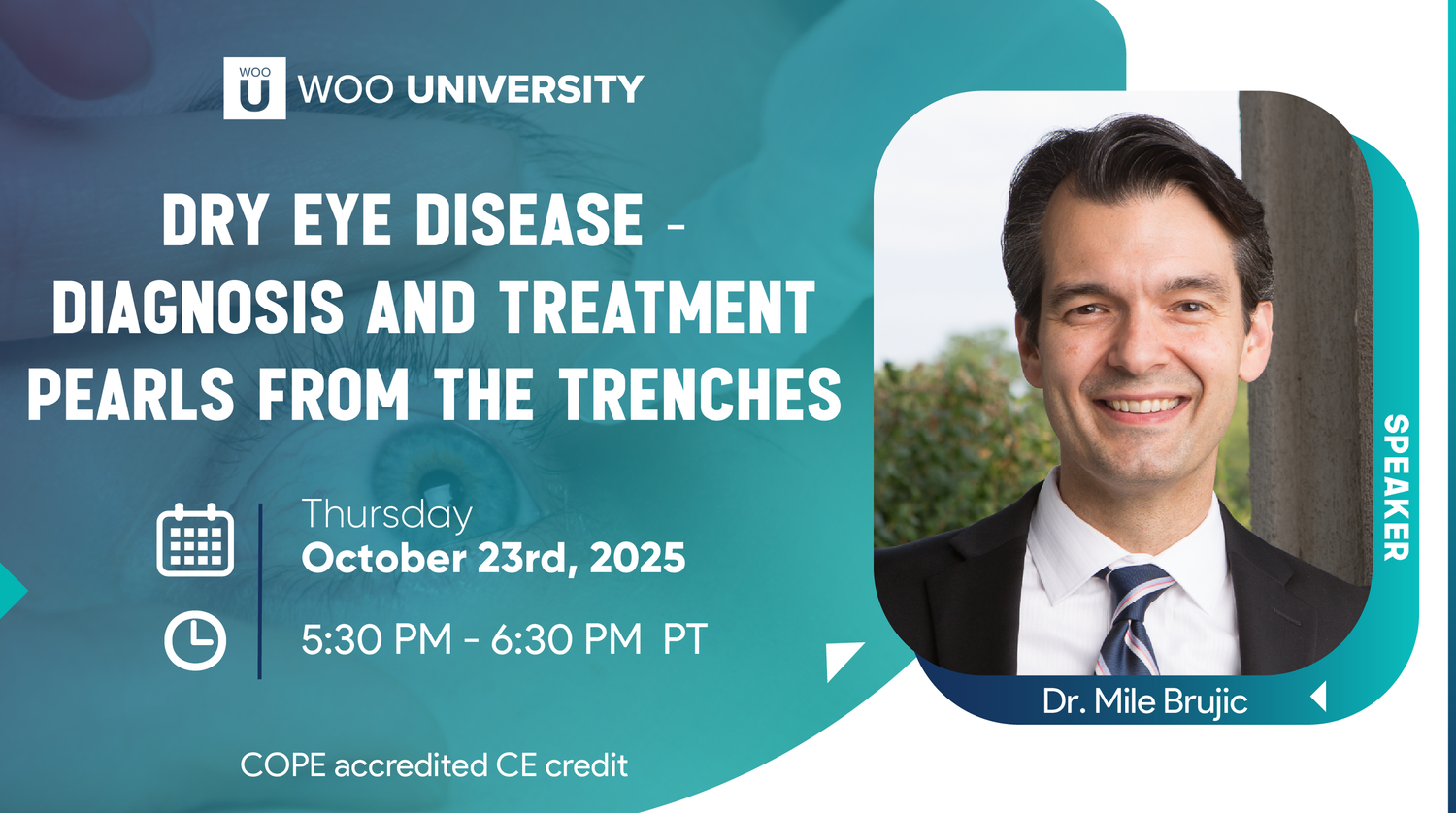Comprehensive Eye Care Today: Expert Pearls on Cataracts, Corneal Lenses, and Presbyopia Therapy
Explore the latest advances in cataract surgery, corneal GP lens applications, dry eye management, and pharmacologic treatments for presbyopia. This post highlights key clinical pearls and practical takeaways from leading experts in modern eye care.
Cutting Edge Cataract Care: Cases and Considerations
Dr. Schweitzer emphasized how cataract surgery has evolved from simply restoring vision to being one of the most powerful refractive procedures we can offer. Today’s outcomes depend not only on surgical skill but also on optimizing the ocular surface, getting accurate measurements, selecting the right IOL, and setting the right expectations with patients.
Key takeaways:
Ocular surface first: Dry eye is highly prevalent in cataract patients and often goes undiagnosed. Addressing tear film instability and meibomian gland dysfunction before surgery is critical to avoiding refractive surprises and unhappy patients
IOL options are expanding: Monofocals remain reliable, but newer EDOF and multifocal lenses can extend ranges of vision. Each has tradeoffs, such as halos or glare. Light adjustable IOLs are particularly exciting because they allow fine tuning after surgery.
Astigmatism management: Residual astigmatism remains one of the most common challenges. Surgeons have multiple options—toric IOLs, limbal relaxing incisions, laser enhancements, or even IOL rotation—to achieve sharper outcomes.
Less Drops trend: Many surgeons are moving toward intracameral injections at the time of surgery, reducing the burden of multiple postoperative drops and improving adherence.
Expectations are everything: Clear preoperative counseling is essential. Patients considering premium lenses must understand the potential for photic phenomena, the time needed for neuroadaptation, and that a small percentage may ultimately require IOL exchange.
Bottom line: Modern cataract surgery is refractive surgery. Success comes from treating the surface first, measuring carefully, choosing the right lens, and aligning expectations—steps that together deliver the best possible vision and satisfied patients.
Corneal GP Lenses Are Alive and Well
Dr. Tom Quinn’s message is clear and energizing: corneal GP lenses are far from obsolete. They remain one of the most powerful and precise tools in specialty contact lens practice.
In his Woo U presentation, Dr. Quinn walks us through why corneal GPs still deserve a strong place in today’s fitting arsenal and shares practical pearls to help make them a reliable, modern option for your patients.
Key Takeaways:
Why choose corneal GPs?
Unmatched optical quality, long-term durability, affordability, and simple handling — with excellent oxygen transmission and fewer tear-film complexities than sclerals.
Reframing comfort
Patient language matters. Dr. Quinn recommends describing lens “awareness” or “adaptation” (not “discomfort”) and using techniques like the sandwich method to boost confidence during the adaptation period.
A systematic fitting strategy
Start with diameter: use HVID/VVID and lid position to choose between lid-attachment or interpalpebral designs.
Refine base curve: align mid-peripheral touch with desired movement; smaller lenses need steeper curves.
Apply SAM/FAP logic (Steeper Add Minus, Flatter Add Plus) when adjusting power.
Fluorescein is your guide: look for 30–50 µm central clearance and smooth edge lift.
Document parameters clearly to track what works for each lid and corneal profile type.
When to go toric or bitoric
Consider it for >2D corneal toricity, >30 µm elevation difference on 8 mm topo, or >0.15 e-value differential — toric GPs often outperform soft torics in stability and vision.
Multifocal & presbyopic GPs
Choose the design for the task: aspheric for smooth transitions, translating for sharper near vision.
Control centration: proper lid attachment and diameter choices improve multifocal optics.
Optimize segment height: small changes dramatically affect reading comfort.
Train the brain: encourage consistent wear for neuroadaptation. n.
Centration is king
Control lens weight: adjust center thickness or material density to balance gravity and lid force.
Use prism ballast or diameter tweaks to enhance centration and reduce rotation.
Observe in blink and upgaze: stable centration through motion ensures consistent optics and comfort.
Why it matters:
Dr. Quinn reminds us that modern corneal GP lenses are alive, well, and thriving. With thoughtful design and confident patient communication, they continue to deliver exceptional precision, adaptability, and satisfaction.
From Dry Eye to Presbyopia: Practical Pearls and Pharmacologic Advances in Modern Eye Care
Pharmacologic Treatments for Presbyopia: Navigating Current Options
Dr. Kaleb Abbott’s presentation focused on the latest pharmacological approaches to managing presbyopia.
He started by discussing pharmacological management of presbyopia, including the goal of miosis, as well as cholinergic muscarinic agents and sympathomimetic agents.
He also discussed problems with ciliary muscle stimulation, including pseudo-myopia, ciliary spasms, headaches, anterior lens displacement (vitreoretinal traction and posterior synechiae formation).
In addition, Dr. Abbott spoke about current and future options for presbyopia treatment, including Vuity, Qlosi, Vizz, and Brimochol. He also discussed the benefits and side effects of each drop, as well as pupil size and performance metrics.
Dry Eye Disease: Diagnosis and Treatment Pearls from the Trenches
Dr. Mile Brujic started by discussing the importance of using magnification to look carefully at the lid margins.
He then talked about diagnostic tools and strategies, including different stains, InflammaDry, ScoutPro, corneal sensitivity, meibography, the proparacaine challenge test, and corneal esthesiometry.
He spoke about the association of facial rosacea with ocular rosacea.
He finished with a discussion about different treatments, both procedural and treatment-based.
Thank you for sharing your wisdom with the Woo U community!




